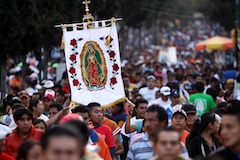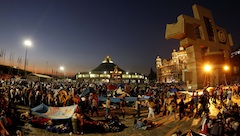|
|
|
|
 |
|
Mexico City
 |
 |
 |
Pilgrims in procession to the Basilica of Our Lady of Guadelupe |
This page has not been updated since June 2014.
Christian (Catholic) pilgrim site
Founded by the Aztec people in the 14th century, Mexico City has grown into the largest metropolitan agglomeration in the Western hemisphere, with a population of over 21 million.
On a hill outside the city the Basilica of Our Lady of Guadelupe is one of the most visited pilgrimage sites in the world, thought to bring over 20 million visitors a year.
The Basilica marks the place where, in 1531, a Mexican peasant had a vision of the Virgin Mary who instructed him to build a church in her honour. Several miraculous events followed, including the appearance of the image now known as The Virgin of Guadalupe (this icon is on display in the Basilica) and the church was built as a consequence.
 |
 |
 |
Pilgrims setting up makeshift tents outside the Basilica in Mexico City |
9 million pilgrims attend the festivities of the celebration of Our Lady of Guadalupe which is held in mid December each year. After the Celebration, however, the streets are covered with plastic bottles, cans, with human and dog waste, the air is polluted with traffic, fireworks and firecrackers and the city’s parks and flowerbeds are damaged.
Now the government plans to launch the first green pilgrimage to the Basilica of Guadalupe -The Guadalupana Green Pilgrimage 2013- which will take place this December. Working with government ministries, schools, the media and the Basilica itself it will 'green' the flagship pilgrimage routes from the west and the northwest, introduce an anti litter campaign for pilgrims, set up new hydration stops along pilgrimage routes and new environmentally friendly portable restrooms for pilgrims. The message of green pilgrimage will be promoted during Sunday masses.
Mexico City website
Shrine of Our Lady of Guadelupe website
|
 |
|
|
|
|
|
 |
Green pilgrimage network members
The vision is of pilgrims on all continents and the pilgrim cities that receive them, leaving a positive footprint on the Earth |
 |
Green Pilgrimage Network launches in n faith, hope and joy
A ban on cars on pilgrimage routes; solar panels for cathedral roofs; provision of fresh clean, water for pilgrims; the planting of thousands of trees around sacred sites - these are some of the initiatives to be implemented by founder members of the Green Pilgrimage Network. |
 |
UK Catholics: The Call to Creation
"It is not wrong to want to live better. What is wrong is a style of life... directed towards having rather than being." A Catholic response to the environmental crisis. |
 |
 |
|
|

